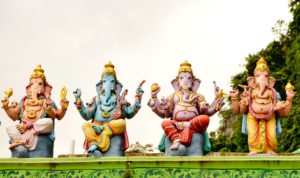In this article, I’ve said that as a yogi you should read about the yoga sutras. It’s gonna be hard to talk about them all, so this is why I’ve chosen to expand a bit more on the eight limbs of yoga, which you will also find as Ashtanga yoga. I will zoom in a little bit on the first limb, which is Yamas.
Patanjali
Here’s a little something about Patanjali. First of all, he is supposed to be the author of the yoga sutras. It doesn’t mean that he invented them, but he was the first one to write them down. The reason why I’m saying this is that in the past the discipline of yoga was transferred from teacher to student by word. Nothing was written down and it was seen as a sacred and secret discipline that could only be passed on verbally.

Anyway, yogi’s around the world are glad they have this documentation of the sutras and they are a good guide on how to live your life the yogi way. If you’d like to read the yoga sutras yourself, click here for my review on the book.
Ashtanga/Eight limbs
So, as I said before, Patanjali wrote about eight limbs. I’m gonna name all of them, but in this article I will mostly focus on the yamas.
- Yama
- Niyama
- Asana
- Pranayama
- Pratyahara
- Dharana
- Dhyana
- Samadhi

It means that it’s a bit of a guided plan to reach enlightenment (Samadhi). The first four are mostly outer.
So Yama and Niyama are focusing on your behavior, more explanation will follow. Asanas, are the postures, which is bodywork to go into meditation, a preparation to make sure that you will be able to sit comfortably for a long period. And Pranayama is controlling the breathing.
The other four are concentrated on going to the inside. So they basically they are going into the silence. Going from the focus on the outside world and taking it inside. Reflecting upon yourself, your breathing, your habits, … to finally reach the point where you are completely in bliss.
I know it sometimes might sound all a little bit airy, but if you’re doing yoga already, then you already know what I’m talking about. If you aren’t doing yoga yet, look at these YouTube channels that I recommend. They are very grounded and they might be a good start to start your own practice.
The Yamas
These are practically the don’ts in Hinduism and within Yoga as well. I always think it’s a bit harsh to call them but they are similar to the 10 amendments in Christianity. Every religion has them and they are a good guide of how to live your life. Not because I think they will guide you to heaven (although I’m not skeptical about religion), but because I believe these do’s and don’ts will actually make your life easier. There are 5 yamas:
- Ahimsa
- Satya
- Asteya
- Brahmachayra
- Aparigraha
1. Ahimsa

Ahimsa goes a bit further than that. It’s not only that you can’t kick your boss in the ass although he might be sometimes a jerk, it also means that you have to contemplate why he is a jerk and feel compassion for him.
It might be that your boss is going through a rough time, which is why he’s putting it out on others, without even realizing it. So, Ahimsa at this point means that you don’t have to take it personally and that you have to have some compassion for your boss. Maybe even try to do something nice to cheer him up.
Besides that, Ahimsa also means no-violence towards yourself. And now I’m not only talking about hurting yourself physically, but also mentally. It means that you have to think about yourself in a nice and loving way.
It’s something that we’ve lost a lot in the last decades, but it’s something that we must think about again. It’s not a synonym for narcissism, because then you just have a lack of compassion as well.
It’s about not beating yourself up when not everything is going according to plan, it’s about leaving a situation where you aren’t treated nicely and you don’t have to put up with it.
2. Satya
Truth, that is what Satya means. It sounds easy doesn’t it, don’t tell any lies. But it’s more than that. Truth is more than not telling lies according to the yoga sutras.
Of course, it’s also a part of it. I know it’s not always hard not to lie because sometimes you just have to tell a white lie of you are trying to protect someone. That’s my interpretation of course. I assume that Patanjali didn’t see it that way.

It’s about communication without any judgment. I know, this sounds very hard, but in my education, we did a lot of communication, and it’s practically about not hurting anyone with your language.
For example, if someone is doing something you think was kind of dumb, you could call him stupid. Better would be that you don’t feel that his behavior didn’t look like the best action to you.
I know, it does sound complication, but by keeping something close to you, you don’t hurt someone else and you actually might get a very nice response back. Something like: “Oh sorry, I didn’t think it would’ve been weird to you, thank you for telling me.”
This way it doesn’t only give you a better reaction, but it also doesn’t awake a lot of emotion within either of you.
Although this is one of the yamas, this might actually a nice way to communicate with others in general and there is actually a term for it as well within psychology: Non-Violent Communication.
3. Asteya
Non-stealing is what Asteya stands for. It’s not only about stealing things from others, like pickpocketing. It’s also about not stealing ideas from others, not stealing someone else’s job, etc. It’s also about not chasing fame or glory.

So when you go to the supermarket next time, try to see that whatever you are buying, is that everything that you really need?
It might be that you took the last package of yogurt, just because you felt that you might be needing it. But think again, what if someone actually needed that package of yogurt, then that’s considered “stealing” in this philosophy as well.
As you can see it’s not that easy. And to translate it a bit into yoga terms as well. When you enter your yoga class, do you really need to be in the front to outshine others, or is it time to have a look if someone actually needs to be in the front, someone who might need some extra guidance?
Then maybe it’s time to stop stealing her spot and be the knight in shining armor to offer her that place in the studio.
4. Brahmacharya
The fourth one is going to be a bit harder to explain as everyone has put his own meaning to it and it’s not such an easy subject to talk about as well. But here it goes: Celibacy. Brahmacharya is the equivalent of Wester celibacy.
I know it’s not always so accepted to talk about this subject, so if you would feel offended, please skip this one and go straight to the next one. For those who do wanna read and talk about it, you can just read on ;).

It’s not about being prude, but it has more to do with intimacy. Because first of all, there is a difference between having sex and making love.
If you don’t know the difference between the two of them, the first is just because you feel the urge of engaging into sexual activities, and the latter is about actually engaging with someone else but completely committed with your whole heart and all senses.
In all religions, they speak about not having any intercourse at all until you are married. Except in Hinduism, they have a small nuance. They see life a bit more chronologically and they actually explain that life has a couple of stages.
The first stage is where you grow up. So up until the age of around 25, you should be focusing on going to school, getting an education, and getting your first job experiences, after that, it’s time to build a family.
And then somewhere after the age of 55, when your kids are all married and have kids, that’s the time that you would start to contemplate and meditate.
I might have forgotten one stage, but my meditation teacher taught me this in India, and I didn’t write it down.
So, in Hinduism, they speak a bit about focus and energy. And that’s a bit the same in the spiritual world.
Of course, it’s okay to have intercourse and to share beautiful moments with the person you are dating or even in love with.
In the spiritual world they actually often speak about the Hara, which is your energy center around your naval or solar plexus. This is also where all energy resides, some call it Kundalini, others call it the sex center (as from this energy all life has been born).
That said, it actually means that when you are not aware and you are just engaging in sexual activities from the urge that you are feeling, you are wasting your energy and losing your focus.
Brahmacharya also is translated into “right use of energy” and it’s about the difference between just feeling an empty pleasure or a fulfillment.
5. Aparigraha
The last one is all about non-attachment. Of course, this couldn’t be missing on this list! It sounds easier than it looks as we live in a society where it is all about collecting and buying the newest gadgets.

You also find this philosophy a little bit in the minimalistic movement, and I feel they translate it a bit better and grounded than the spiritual movement is.
They consider that the attachment and gathering of things are actually interfering with the relationships you are having. If you let go of the necessity you feel about buying, you will have more time and money to spend with your family and friends.
Besides that, you’ll also find a lot more pleasure in your daily life as you won’t have a lot of things to worry about, and you will feel more content as you have more time to relax and contemplate as well.
Conclusion
Those were the five yamas from Patanjali. There is a lot more philosophy than this, so if you are interested in hearing more, leave some comment down below to let me know which subject you’d like to talk about next.
And for now,
Nama-stay wonderful!









I am a yoga fan and have been for many years. This article was very enjoyable for me to read. It highlighted the reasons why yoga is good for us both physically and mentally. I really do need it sometimes to quiet my mind and to immerse myself in some form of calmness.
I liked your explanation of the yamas and why they do indeed help us.
Great post
Thank you
Louise
Thank you Louise, it means a lot to me that people are enjoying my articles. And I’m glad that you enjoyed it!
Wow, it’s very awesome to learn the yamas you have written here. I didn’t know about the difference between making love and having sex before really. Lol. It’s embarrassing but it’s really good to learn about that. I think my yogi needs to see this post you have written here. I’d like to learn more philosophies so please do add some more
Thanks.
Hi John,
Great that you enjoyed it, and yeah, there is a huge difference between the two of them, but don’t worry, I think there are more people that don’t know the difference ;).
I will write more articles about the philosophy! So come on back every now and then to have a look!
Well!!! Well!!! Well!!! I just had a full session of self improvement, self awareness and mental development right here. When I was reading your article I didn’t even care about the pronounciation of these yoga sutras. All I knew about yoga was to switch on soul music and concentrate on your inside world. This great information related with discipline of the mind.
Honestly most times my boss hurt my emotions after a long day of work and i would hide in the corner of the room and throw words at him silently but now that I come to think of it, he was trying to make ends meet for himself too. I feel like a whole burden has been thrown off my head.
Thanks for the sutras. Am so interested in yoga now.
Nama-stay
Hi Brendah,
I’m glad you enjoyed the article. And sad to hear that your boss is actually treating you like that. Just remember, even if he’s acting like that, also look at how it makes you feel. Like within Ahimsa, hurting yourself is not non-violent as well.
Such an enlightening post for the day. You have a well researched article with enriching examples to make it more understandable. The five yamas of Patanjali certainly guide us with the basics of good morals. All these good values must be instilled among us so we can apply it to our daily lives.
Honestly, I always have a perception that yoga is just a peaceful exercise.I never thought that it’s actually give a way of life, providing us with ways on how to live harmoniously with the world. There are 7 more of the Ashtanga that probably has deeper concept. This article makes me want to know more about yoga and its teachings. Thank you for sharing this with us. I have learned a bit of history and more of values.
Hi MissusB,
I’m glad you enjoyed reading the article! Make sure you have a look every now and then as I will be adding more articles on the 8 limbs of yoga!
Very informative and shades good light on yoga. I have known yoga to involve meditation but this shows aspects not known to me, helpful aspects I might add. I have downloaded some meditation YouTube videos but, as stated in the article, my body needs some training to be able to seat in one position for an extended period.
I personally love the Barhmarchayra, that of one wasting away their energy. In today’s world sexual activity is just one of those things like eating ice cream but this philosophy brings to mind that there is more to it and more is lost that gained.
I would appreciate a bit detail on the concept of chronology in the same Barhmarchayra. Is it that after one reaches 25 they can engage in sexual activity or is it focusing on one having a family?
Hi Patrick,
Thank you for reaching out. Up until the age of 25 (approximately) your energy should be focused on personal development like education and growing into to person you are becoming. But this is according to some Hindu philosophy. After that age it’s time to start a family, but that also goes together with engaging in sexual activity, as to get the first one, you’ll need to do the second one ;).